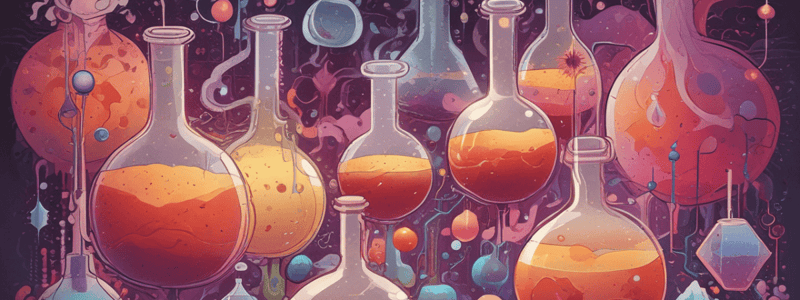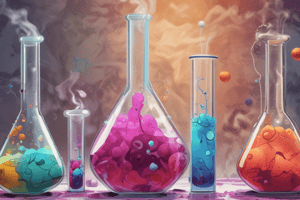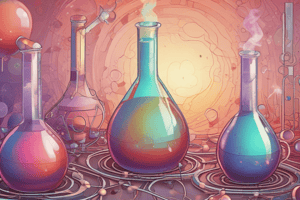Podcast
Questions and Answers
What is the correct order of balancing atoms in a chemical equation?
What is the correct order of balancing atoms in a chemical equation?
- Other atoms, then hydrogen, oxygen, and finally atoms that appear in only one molecule
- Balance atoms that appear in multiple molecules, then hydrogen, oxygen, and finally other atoms
- Hydrogen and oxygen, then other atoms
- First balance atoms that appear in only one molecule, then hydrogen, oxygen, and finally other atoms (correct)
What is evaporation, in terms of phase change?
What is evaporation, in terms of phase change?
- The process of changing from a solid to a liquid
- The process of changing from a gas to a liquid
- The process of changing from a gas to a solid
- The process of changing from a liquid to a gas or vapor (correct)
What determines the properties and reactivity of an atom?
What determines the properties and reactivity of an atom?
- The number of electron shells
- The number of protons in the nucleus
- The number of electrons in the outermost energy level (correct)
- The number of neutrons in the nucleus
What is the relationship between the group number and the number of valence electrons in an atom?
What is the relationship between the group number and the number of valence electrons in an atom?
What is the maximum number of electrons that a d orbital can hold?
What is the maximum number of electrons that a d orbital can hold?
What is the term for the size of an ion, depending on whether it gains or loses electrons?
What is the term for the size of an ion, depending on whether it gains or loses electrons?
What happens to the atomic radius of an atom when it loses an electron to become a cation?
What happens to the atomic radius of an atom when it loses an electron to become a cation?
Why do atoms at the top right of the periodic table have higher ionization energy requirements?
Why do atoms at the top right of the periodic table have higher ionization energy requirements?
What is electronegativity?
What is electronegativity?
What determines the degree of bond polarity?
What determines the degree of bond polarity?
What is a characteristic of main group elements?
What is a characteristic of main group elements?
What is the significance of the number of electron orbitals surrounding an atom's nucleus?
What is the significance of the number of electron orbitals surrounding an atom's nucleus?
What is the formula to calculate the density of an object?
What is the formula to calculate the density of an object?
What is the force created on the bottom of an object when submerged in a fluid?
What is the force created on the bottom of an object when submerged in a fluid?
What is the purpose of a hypothesis in the scientific method?
What is the purpose of a hypothesis in the scientific method?
What is the term for a scientist's evaluation of another scientist's work?
What is the term for a scientist's evaluation of another scientist's work?
What is the term for a hypothesis that is widely supported by empirical research?
What is the term for a hypothesis that is widely supported by empirical research?
What is the first step in the experimental design process?
What is the first step in the experimental design process?
What is the purpose of coefficients in a balanced chemical equation?
What is the purpose of coefficients in a balanced chemical equation?
What is the result of a chemical reaction on the arrangement of atoms in the reacting molecules?
What is the result of a chemical reaction on the arrangement of atoms in the reacting molecules?
What is the difference between reactants and products in a chemical reaction?
What is the difference between reactants and products in a chemical reaction?
What is the law of conservation of matter, as it relates to chemical reactions?
What is the law of conservation of matter, as it relates to chemical reactions?
What is the significance of the reactants and products having the same number of atoms?
What is the significance of the reactants and products having the same number of atoms?
What would happen if subscript numbers in a chemical equation were changed?
What would happen if subscript numbers in a chemical equation were changed?
What is a science experiment?
What is a science experiment?
What is the purpose of keeping everything else constant in an experiment?
What is the purpose of keeping everything else constant in an experiment?
What is the relationship between the accuracy and reproducibility of data?
What is the relationship between the accuracy and reproducibility of data?
What is the median of a dataset?
What is the median of a dataset?
What is the independent variable in an experiment?
What is the independent variable in an experiment?
What is the graph of a linear relationship?
What is the graph of a linear relationship?
What is the purpose of regression in understanding the relationship between two variables?
What is the purpose of regression in understanding the relationship between two variables?
What is the scientific method?
What is the scientific method?
Why do we calculate values based on other data in scientific analysis?
Why do we calculate values based on other data in scientific analysis?
What is the purpose of rearranging formulas in scientific analysis?
What is the purpose of rearranging formulas in scientific analysis?
What is a characteristic of elements in groups 1, 2, and 13?
What is a characteristic of elements in groups 1, 2, and 13?
What is unique about transition metals?
What is unique about transition metals?
What is the basis of life on Earth?
What is the basis of life on Earth?
What is the function of carbon in the body?
What is the function of carbon in the body?
What is a characteristic of living things?
What is a characteristic of living things?
What affects how clouds float at different altitudes?
What affects how clouds float at different altitudes?
Study Notes
Chemical Reactions
- A chemical reaction is a process where bonds are formed and broken, and atoms are rearranged.
- A chemical reaction has two parts: reactants (starting materials) and products (resulting chemicals).
- The Law of Conservation of Matter states that matter cannot be created or destroyed, so the number of atoms of each element is the same in reactants and products.
Balancing Chemical Equations
- A balanced chemical equation is one where the number of atoms of each element is equal on both reactant and product sides.
- To balance a chemical equation:
- Change a word equation into a formula equation.
- Balance each atom one at a time.
- First, balance any atoms that appear in only one molecule on the product and reactant sides.
- Then, balance non-hydrogen and oxygen atoms.
- Finally, balance hydrogen and oxygen atoms.
Phase Changes
- Phase changes occur when energy and pressure are added or removed from a system.
- The three main phases found in nature are solid, liquid, and gas (vapor).
- Types of phase changes:
- Evaporation (liquid to vapor)
- Condensation (vapor to liquid)
- Sublimation (solid to vapor)
- Deposition (vapor to solid)
- Freezing (liquid to solid)
- Melting (solid to liquid)
Valence Electrons
- Valence electrons are the electrons in the outermost energy level of an atom.
- The number of valence electrons determines an atom's properties and reactivity.
- The group number of an atom can be used to determine the number of valence electrons.
Ionic Radius
- Ionic radius describes the size of an ion.
- Anions (negatively charged ions) have larger ionic radii than their parent atoms.
- Cations (positively charged ions) have smaller ionic radii than their parent atoms.
Electronegativity
- Electronegativity is the ability of an atom to attract and hold electrons.
- Electronegativity values range from 0.7 to 3.98.
- Electrostatic attraction between atoms with different electronegativities can lead to the formation of polar bonds.
Periodic Table
- The periodic table is organized by groups (columns) and periods (rows).
- Main group elements are in groups 1, 2, and 13-18.
- Transition metals are in groups 3-12.
- Properties of elements vary greatly depending on their position in the periodic table.
Carbon
- Carbon is an element with 6 protons and 6 neutrons in its nucleus, and 6 electrons orbiting around it.
- Carbon is the basis for life on Earth, and is found in all living things.
- Carbon has many different shapes and forms, including diamonds, graphite, charcoal, and coal.
Living Things
- Living things are systems made up of interdependent parts that are able to stay alive.
- Characteristics of living things include:
- Organized structure
- Ability to grow
- Use of energy
- Response to environment
- Adaptation and homeostasis
- Reproduction
Density
- Density is a measure of how compact something is.
- Density affects everyday life, such as how clouds float at different altitudes, and why objects float or sink in water.
- Density is calculated by dividing mass by volume.
Buoyancy
- Buoyancy is the ability of an object to float when submerged in a fluid.
- The buoyant force of an object is equal to the weight of the fluid that is displaced by the object.
Scientific Method
- The scientific method is a series of steps used by scientists to answer questions about the world.
- Steps of the scientific method include:
- Asking a question
- Conducting background research
- Creating a hypothesis
- Conducting an experiment
- Analyzing data
- Forming a conclusion
Experimental Design
- Experimental design is an invaluable process in the scientific community to provide data to support or refute a hypothesis.
- Steps in the experimental design include:
- Defining variables
- Formulating hypotheses
- Creating an experimental design process
- Assigning subjects
- Measuring the dependent variable
Central Tendency
- Central tendency is a way of summarizing data with a single number.
- Measures of central tendency include:
- Mode (most frequently occurring value)
- Mean (average value)
- Median (middle value)### Regression Analysis
- A regression curve can be plotted on a graph to visualize the relationship between x and y variables.
Scientific Method
- The scientific method involves:
- Recognizing and formulating a problem
- Collecting data through systematic observation, measurements, and experiments
- Formulating, testing, and modifying the hypothesis
Ideal Experiments
- In ideal experiments, two variables are used:
- One variable is changed (independent variable)
- The effect of the change on the other variable (dependent variable) is observed
Calculating Unknown Values
- In scientific analysis, values are often calculated based on other collected data.
- This is done when obtaining the unknown value is difficult or time-consuming.
- If only one value is missing from an equation, it can be easily determined using the other known values.
- Formula rearrangement may be necessary to calculate the missing value.
Studying That Suits You
Use AI to generate personalized quizzes and flashcards to suit your learning preferences.
Description
Learn about chemical reactions, including reactants, products, and how they are written. Understand the basics of chemical reactions and their components.




